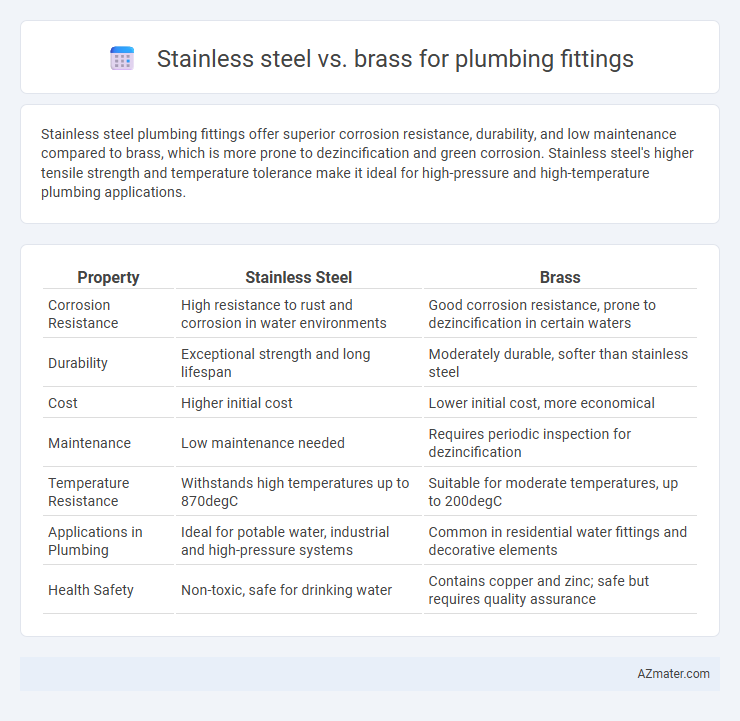Stainless steel plumbing fittings offer superior corrosion resistance, durability, and low maintenance compared to brass, which is more prone to dezincification and green corrosion. Stainless steel's higher tensile strength and temperature tolerance make it ideal for high-pressure and high-temperature plumbing applications.
Table of Comparison
| Property | Stainless Steel | Brass |
|---|---|---|
| Corrosion Resistance | High resistance to rust and corrosion in water environments | Good corrosion resistance, prone to dezincification in certain waters |
| Durability | Exceptional strength and long lifespan | Moderately durable, softer than stainless steel |
| Cost | Higher initial cost | Lower initial cost, more economical |
| Maintenance | Low maintenance needed | Requires periodic inspection for dezincification |
| Temperature Resistance | Withstands high temperatures up to 870degC | Suitable for moderate temperatures, up to 200degC |
| Applications in Plumbing | Ideal for potable water, industrial and high-pressure systems | Common in residential water fittings and decorative elements |
| Health Safety | Non-toxic, safe for drinking water | Contains copper and zinc; safe but requires quality assurance |
Introduction to Plumbing Fittings Materials
Stainless steel and brass are two leading materials used in plumbing fittings due to their durability and corrosion resistance. Stainless steel offers superior strength and is ideal for high-pressure applications, while brass provides excellent machinability and antimicrobial properties, making it suitable for potable water systems. Selecting between stainless steel and brass depends on factors like water composition, temperature tolerance, and cost considerations in plumbing installations.
Key Properties of Stainless Steel and Brass
Stainless steel plumbing fittings offer exceptional corrosion resistance, high tensile strength, and durability, making them ideal for high-pressure and high-temperature applications. Brass fittings provide excellent machinability, natural antimicrobial properties, and good corrosion resistance, particularly in water systems, but are generally softer and less durable than stainless steel. Choosing between stainless steel and brass depends on factors like required strength, exposure conditions, and cost-effectiveness.
Corrosion Resistance Comparison
Stainless steel plumbing fittings exhibit superior corrosion resistance due to their chromium content, which forms a passive oxide layer that prevents rust and degradation in various environments, including exposure to water and chemicals. Brass fittings, while also corrosion-resistant and commonly used for water supply lines, are more susceptible to dezincification and may corrode in highly acidic or alkaline conditions. Choosing stainless steel ensures longer-lasting performance and reduced maintenance in plumbing systems exposed to harsh or variable water chemistries.
Strength and Durability Factors
Stainless steel plumbing fittings offer superior strength and corrosion resistance, making them ideal for high-pressure systems and long-term durability in harsh environments. Brass fittings provide excellent corrosion resistance and ease of machining but tend to be softer and more prone to deformation under heavy stress. For applications demanding maximum strength and longevity, stainless steel is generally preferred due to its robust structural integrity and resistance to wear.
Cost Differences and Budget Considerations
Stainless steel plumbing fittings generally cost more than brass due to higher raw material prices and manufacturing complexity, making brass a budget-friendly option for residential plumbing projects. Brass fittings offer good corrosion resistance and durability at a lower upfront cost, but stainless steel provides superior longevity and resistance to harsh conditions, potentially reducing long-term maintenance expenses. Budget considerations should include initial purchase price, expected lifespan, and environmental factors influencing material performance to ensure cost-effective plumbing solutions.
Installation and Maintenance Requirements
Stainless steel plumbing fittings offer superior corrosion resistance and durability, requiring minimal maintenance compared to brass, which is prone to dezincification and requires regular inspection in aggressive water conditions. Installation of stainless steel fittings often demands specialized tools and expertise due to their hardness, whereas brass fittings are easier to cut and thread, facilitating quicker and simpler installation. The maintenance benefits of stainless steel, combined with its robustness, make it a preferred choice for long-term plumbing projects despite higher initial installation complexity.
Health and Safety Implications
Stainless steel plumbing fittings offer superior corrosion resistance and do not leach harmful metals, making them safer for potable water systems compared to brass, which can contain lead and increase health risks. Brass fittings may release lead in low-level quantities, potentially causing lead poisoning, especially in children and sensitive populations. Choosing stainless steel minimizes the risk of metal contamination, ensuring safer drinking water and compliance with stringent health regulations.
Environmental Impact and Sustainability
Stainless steel plumbing fittings offer superior sustainability due to their high recyclability rate, corrosion resistance, and longer lifespan, significantly reducing environmental waste compared to brass. Brass fittings, while durable and resistant to corrosion, contain copper and zinc, which require energy-intensive mining and refining processes, contributing to higher environmental impact. Opting for stainless steel supports lower carbon footprints and enhanced resource efficiency in plumbing systems.
Typical Applications in Plumbing Systems
Stainless steel plumbing fittings are commonly used in high-pressure water systems, industrial pipes, and corrosive environments due to their excellent corrosion resistance and durability. Brass fittings are preferred for residential plumbing, water supply lines, and valve components because of their machinability, moderate corrosion resistance, and antimicrobial properties. Both materials serve vital roles: stainless steel is ideal for long-lasting infrastructure requiring strength, while brass fits applications prioritizing ease of installation and resistance to dezincification.
Making the Right Choice: Stainless Steel vs Brass
Choosing between stainless steel and brass for plumbing fittings depends on durability, corrosion resistance, and cost-effectiveness. Stainless steel offers superior strength and corrosion resistance, ideal for high-pressure and outdoor applications, while brass excels in ease of installation and antimicrobial properties, making it suitable for residential water systems. Evaluating water quality, environmental conditions, and budget will ensure optimal performance and longevity in plumbing systems.

Infographic: Stainless steel vs Brass for Plumbing fitting
 azmater.com
azmater.com